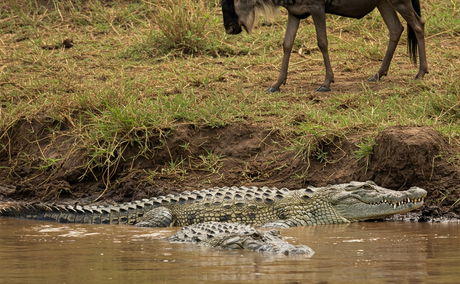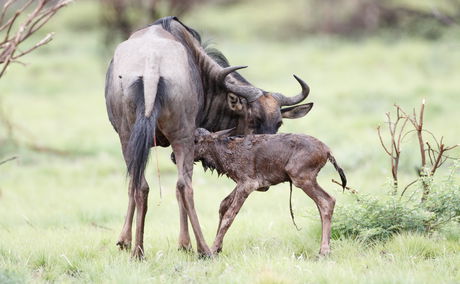The Great Migration is a breathtaking event in nature, with over 1.5 million wildebeests, zebras, and gazelles traversing the Serengeti-Mara ecosystem. Each year, these animals confront the perilous Mara River, home to hungry crocodiles, where hesitation mixes fear with survival instinct. The migration is driven by seasonal rains that dictate grazing availability, underscoring the delicate balance of the ecosystem, with predators like lions playing a crucial role in this dynamic. As wildebeests...
Elephant Herd Tactics: Understanding Their Protective Bunching Behavior
Discover the fascinating survival strategy of elephant herds—bunching behavior. From protecting calves against predators to symbolizing deep family bonds, bunching showcases the intelligence and unity of elephants. However, threats like poaching and habitat loss disrupt these vital instincts, underscoring the need for conservation. Explore these majestic creatures with Kijani Tours and witness their intricate social dynamics firsthand. Embrace responsible tourism and connect with the heart of nature's narrative.
Discover the Hidden Power of Elephant Herds: The Protective Role of Bunching Behavior
In the vast landscapes where elephants roam, survival is a dance between instinct and intelligence. Imagine walking through the African wilderness, observing a herd of elephants suddenly tighten their formation, positioning the youngest and most vulnerable members at the center. What might seem like a simple gathering is, in fact, a remarkable display of strategy, communication, and unwavering protection.
What Is Bunching?
Bunching is one of the most fascinating defensive mechanisms exhibited by elephants. Faced with a potential threat—whether a lurking predator, a sudden disturbance, or an unfamiliar presence—elephants instinctively gather in a close-knit cluster. Their large bodies act as shields, creating an almost impenetrable wall against external dangers. This behavior is particularly crucial for young calves, who rely entirely on the herd for protection.
Bunching behavior is not just a protection—it is a connection.
But bunching isn’t only about defense. Elephants also display this behavior in social interactions, using it as a way to reinforce their strong family bonds. They bunch together in moments of joy, grief, and uncertainty—echoing a deep-rooted understanding of unity and collective care.
Bunching behavior goes beyond physical defense; it's a silent language of care and unity. When elephants cluster together, they shield their vulnerable members from harm while simultaneously fostering emotional support within the herd. It's an extraordinary display of connection as they comfort one another during moments of joy, stress, or uncertainty. This intricate dance of protection and bonding is a testament to the deep intelligence and social depth of elephants, leaving you curious to witness it for yourself.
The Impact of Human Activity on Bunching Behavior
Sadly, disruptions like poaching, habitat loss, and historical culling have altered how elephants form these protective clusters. Studies show that herds suffering from past trauma may struggle to organize themselves cohesively, affecting their ability to shield younger members effectively.
This insight makes conservation efforts even more critical. Understanding elephant behavior helps organizations and safari enthusiasts like Kijani Tours advocate for responsible tourism, ensuring these magnificent creatures thrive in their natural habitat.
Experience the Majesty of Elephant Herds with Kijani Tours
Witnessing bunching firsthand is an experience unlike any other. Whether exploring the savannah at sunrise or observing a herd near a watering hole, each moment unveils the intelligence and resilience of elephants.
To bring it all together, bunching behavior reflects the profound intelligence, unity, and adaptability of elephant herds. This remarkable instinct not only showcases their commitment to protecting the most vulnerable but also highlights their deep social bonds that transcend mere survival. However, human impacts, such as habitat destruction and poaching, threaten these natural behaviors, emphasizing the urgent need for conservation. By safeguarding these magnificent creatures and their environments, we ensure that future generations can continue to marvel at the awe-inspiring resilience and wisdom of elephants in the wild. Together, we can support efforts like those of Kijani Tours, fostering a world where these majestic animals thrive.
Unlock More Insights
Facts About Mount Kilimanjaro takes readers on an inspiring journey into the wonders of this iconic peak. As the world's tallest free-standing mountain, Kilimanjaro captivates with its towering height of 5,895 meters and unique volcanic cones—Kibo, Mawenzi, and Shira. The mountain's diverse ecosystems showcase five climate zones, from lush rainforests to icy arctic conditions, supporting rich biodiversity and endemic species. The melting glaciers highlight the urgent impact of climate change, while Kilimanjaro's...
The Serengeti-Mara ecosystem in Northern Tanzania and Southwestern Kenya is home to the spectacular Great Migration of wildebeests, an awe-inspiring journey of over 650 km each year! Starting from the Masai Mara and ending in Ndutu during the calving season, this migration is a breathtaking natural event that enriches the entire ecosystem. As wildebeests graze on grass, they fertilize the soil and support a rich diversity of life while preventing overgrazing. Their...



Share This Post